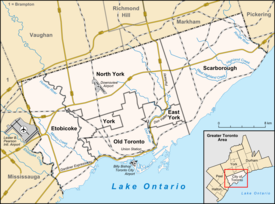Brockton Village
| Brockton | |
|---|---|
| Neighbourhood | |

'Appii Forum', three taverns on Dundas at the tollgate
|
|
| Motto: Industry, Intelligence & Economy | |
 Neighbourhood map |
|
| Location within Toronto | |
| Coordinates: 43°39′00″N 79°26′08″W / 43.65000°N 79.43556°WCoordinates: 43°39′00″N 79°26′08″W / 43.65000°N 79.43556°W | |
| Country |
|
| Province |
|
| City |
|
| Incorporated | 1876 (Village) 1881 (Town) |
| Annexed | 1884 into City of Toronto |
| Government | |
| • City Councillor | Ana Bailão (Ward 18) |
| • Federal M.P. | Andrew Cash (Davenport) |
| • Provincial M.P.P. | Cristina Martins (Davenport) |
Brockton Village is a former town, and now the name of a neighbourhood, in Toronto, Ontario, Canada. It comprises a section of the old Town of Brockton which was annexed by the City of Toronto in 1884. The town encompassed the area from Bloor Street on the north, Dufferin Street on the east, High Park on the west and ranged from Queen Street, along Roncesvalles Avenue, Wright Avenue and Dundas Street to the south. The section south of the rail lines became part of the Village of Parkdale. The section to the west of Lansdowne has become better known as Roncesvalles, around Roncesvalles Avenue. Over the last half of the 20th century, the area south of College Street saw the influx of Portuguese immigrants and is also known as part of the Little Portugal neighbourhood. Today's 'Brockton Village' encompasses that section north of the rail lines between Dufferin and Lansdowne, south of Bloor Street.
In March 1812, Lot 30 in York Township, a 100 acres (40 ha) parcel of land, was granted to James Brock, a cousin of Sir Isaac Brock along with other parcels of land. This lot was a strip of land that stretched from Lot Street, today's Queen Street, north to Bloor Street, west of Dufferin Avenue. After Brock died, his widow Lucy Brock inherited his estate and she began selling the lands that Brock owned. She commissioned a roadway along the centre-line of the lot parcel, along its whole length. The road, built in 1850, is known today as Brock Avenue. The lands of lot 30 were sub-divided for small land-holders and development occurred. This unincorporated settlement took on the name of Brockton.
The developed area of Brockton grew to border High Park on the west, Dufferin (then the border of Toronto) on the east, Bloor on the north and the rail-lines to the south-west by the time it was incorporated as a village in 1876. It became an incorporated town in 1881. The incorporated town only lasted three years before it was annexed by the City of Toronto in 1884.
...
Wikipedia

